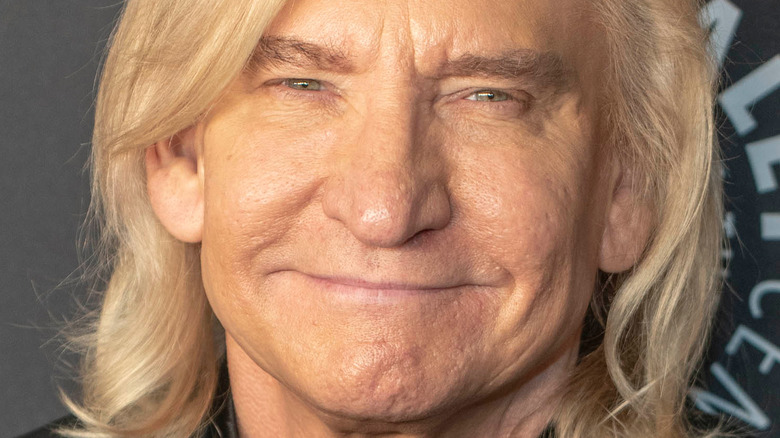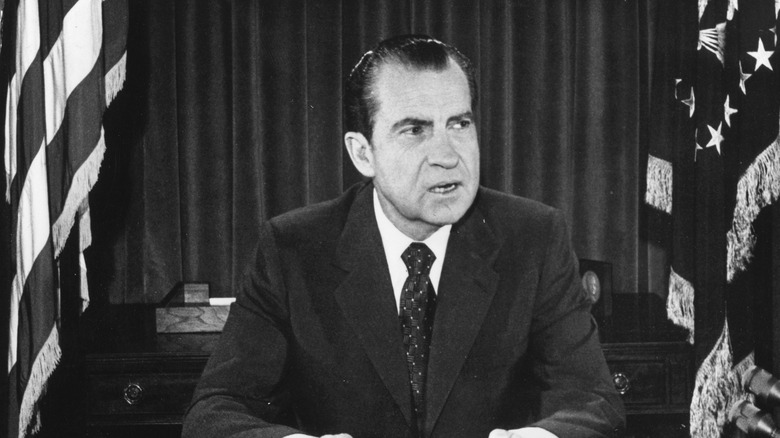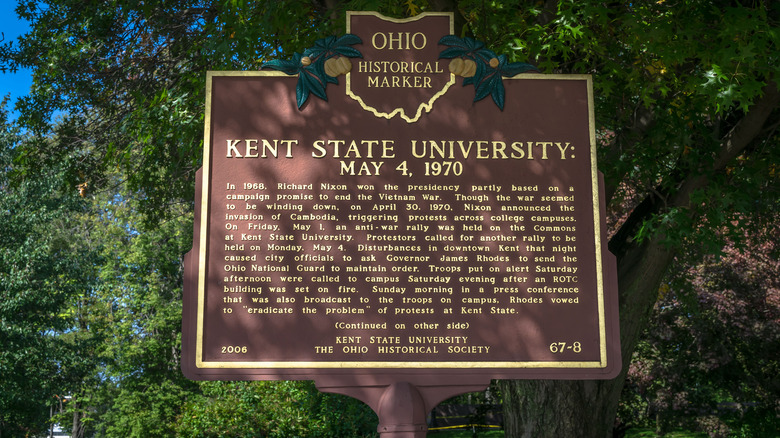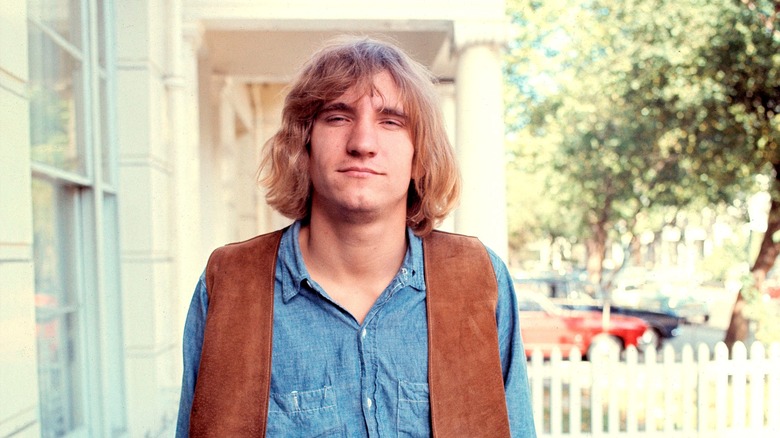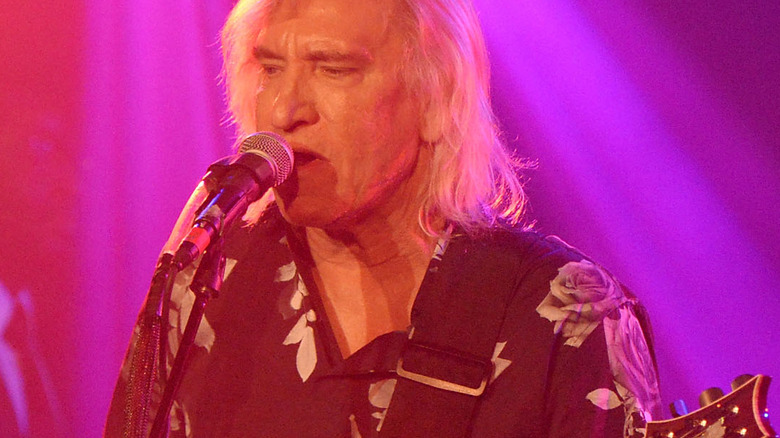How The Kent State Massacre Pushed Joe Walsh Into Music
Over the last 50 years, Joe Walsh has made a name for himself as a rock 'n' roll icon. Walsh's first band, the James Gang, came to prominence in the early-1970s, best known for hits like "Time Won't Let Me." But despite the band's success, Walsh eventually jumped ship and joined one of the biggest bands in history, the Eagles. If that weren't enough, Walsh later went on to have a wildly successful solo career, even playing alongside Ringo Starr & His All-Starr Band.
Given that he's known as a "clown prince of rock 'n' roll," as the Baltimore Sun noted in a 2003 write-up, it may come as a surprise to learn that Walsh's decision to fully pursue music was tied to one of the darker moments in modern American history: the 1970 Kent State shooting, otherwise known as the Kent State massacre. The reason? Walsh was a student at Kent State University in 1970 when Ohio National Guard troops opened fire on a student protest, killing four.
According to History, it was a major turning point in the public's opinion of both the Vietnam War and President Richard Nixon — but for Walsh, it marked a watershed in his own life, too.
The build-up to the student protests at Kent State University
Leading up to the shootings at Kent State in 1970, all of which took place during anti-war demonstrations against the U.S. government, the conflict in Vietnam had been raging all through the second half of the 1960s. It was generally seen as an unpopular war and drew widespread protests from opponents. Then-President Richard Nixon had won the 1968 election on a platform that included a promise to bring an end to the war itself. However, by 1970 — halfway through his first term in office — there didn't seem to be any end in sight. Even worse, the war appeared to only intensify.
On April 30, 1970, President Nixon, in a televised address, announced plans for the United States to invade Vietnam's western neighbor, Cambodia, per History. Generally, younger people were opposed to the ongoing war, which meant college campuses became a frequent site for protests. Nixon's new plan for military action in Cambodia drew criticism and ignited nationwide anti-war demonstrations — including on the campus of Ohio's Kent State University.
The Kent State shooting
According to History, it didn't take long for protests to begin following Richard Nixon's plans to invade Cambodia. At Kent State, protests started on May 1, 1970, the day after Nixon's announcement. The first day of the protest attracted hundreds of students to gather on campus. The following night, there were reports of violence between police and protestors. (However, as Far Out magazine noted in 2021, it is now widely believed the protesters who engaged in vandalism and other forms of violence were not affiliated with Kent State.) By May 2, the Ohio National Guard had been called, per the Kent State University website. Their directive was to allegedly maintain the peace as the protests intensified.
While May 3 was a relatively calm day, the protests ramped up again on May 4 with thousands in attendance. Although the protest was peaceful by all accounts, the National Guard was instructed to disperse the crowd. After the National Guard's initial attempts with tear gas were largely unsuccessful — and the crowd was becoming increasingly angry — demonstrators started to retreat. Despite this, more than two dozen guardsmen were reported to have fired into the fray with a total of over 70 shots within 13 seconds, killing four people and wounding nine others.
Joe Walsh later gave a first-person account about the shooting
Well before the Kent State shooting, Joe Walsh enrolled at the university in 1965. In May 1970, he was working toward an English degree and was there when the events unfolded, per Rolling Stone. In 2020, on the 50th anniversary of the massacre, Walsh wrote on Facebook about what he saw left a major impact on him, along with everyone else who was present that day.
"Those of us who were there remember that day graphically, when our classmates, our friends, got shot down," Walsh wrote in the post, noting that many of those who were protesting that day were barely adults, attending Kent State to further their education. "We were peacefully demonstrating but because of a total dysfunctional authority trying to handle a situation they didn't understand, it mutated into elevated emotions and anger, chaos and fear escalated into violence," Walsh recalled. "The solution then, as it is now, is to be able to peacefully assemble and understand each other and accept our differences, without fear, without hatred, without violence."
How the massacre has affected Joe Walsh
While Joe Walsh was already playing in front of local audiences at the time of the Kent State massacre, the 1970 Kent State shooting prompted him to leave school and pursue music full-time, according to Rolling Stone. Even so, the event made its mark in Walsh's music. In 1972, Walsh wrote the song "Turn to Stone" about the Vietnam War and the way it was handled by the Nixon administration. In 2016, Walsh told Rolling Stone that his experience at Kent State also factored into the song. "I attended Kent State. I was at the shootings," Walsh said of the shooting and its aftermath. "In those days it felt like the government's priority was not the population. They had an agenda that was about something other than doing what was necessarily good for the country."
In 2020, Walsh was scheduled to play at a benefit commemorating the 50th anniversary of what happened that day. The concert itself was intended to benefit the May 4 Legacy Scholarships — four scholarships, one honoring each student killed in 1970, to students enrolled in Kent State's Peace and Conflict Studies program, per Kent State University. Unfortunately, the anniversary benefit was ultimately canceled due to the COVID-19 pandemic.
